Last year’s Miyoo Mini retro gaming handheld was a surprise hit with one fatal flaw: the company couldn’t keep them in stock for more than a couple of minutes. The console would sell out almost immediately and was nearly impossible to buy if you didn’t spend all day tracking stock. The Miyoo Mini Plus is the company’s solution to that problem, but an expanded design has introduced another fatal flaw: a bigger screen.
There were two things that made the original Miyoo Mini so hard to find. First and foremost, it was a fantastic casual gaming device that packed all of the charm of the original Game Boy into a much smaller handheld that was able to emulate classic games, including titles from the original PlayStation, for around $60. But the Miyoo Mini’s 2.8-inch, 640 x 480 screen was incredibly hard for the company to reliably source. So you’ve got an excellent handheld that everyone wants to get their hands on, and a company struggling to actually build them. It was a recipe for disappointment, which left many gamers frustrated.
Advertisement
The Miyoo Mini Plus is less of an update to the original Miyoo Mini, and more like a second swing at bat for the company. It does succeed in many ways—you can actually find it in stock at many retailers—but arriving over a year after the original has given competitors time to introduce similarly spec’d retro gaming handhelds, and as much as I loved the original Miyoo Mini, the Plus is not the retro handheld I recommend, chiefly because of the quality of the screen.
Note: A sample of the Miyoo Mini Plus was provided to Gizmodo by online retailer KeepRetro.
Advertisement
Advertisement
Miyoo Mini Plus
A larger version of last year’s popular Miyoo Mini, the Miyoo Mini Plus is easier to find than the original, but if you’re a retro gaming fan, it’s not the best handheld emulator you can buy right now.
Miyoo Mini Plus
A larger version of last year’s popular Miyoo Mini, the Miyoo Mini Plus is easier to find than the original, but if you’re a retro gaming fan, it’s not the best handheld emulator you can buy right now.
WHAT IS IT?
A larger version of last year’s Miyoo Mini retro gaming handheld featuring a more readily available screen, making it easier for the company to manufacture.
PRICE
$67
LIKE
The larger size makes the Miyoo Mini Plus more comfortable to hold and play, especially if you have large hands. But the best feature of the handheld is that you can actually buy one without having to sign up for waiting lists.
DISLIKE
That larger screen does not look great compared to other handhelds in this price range, and you’ll immediately want to upgrade the Miyoo Mini Plus’ stock OS to something else.
Familiar Hardware With Some Welcome Improvements
The Miyoo Mini Plus’ bump from a 2.8-inch to a 3.5-inch LCD screen results in a slightly larger handheld that I actually find far more comfortable to hold and play than the original.
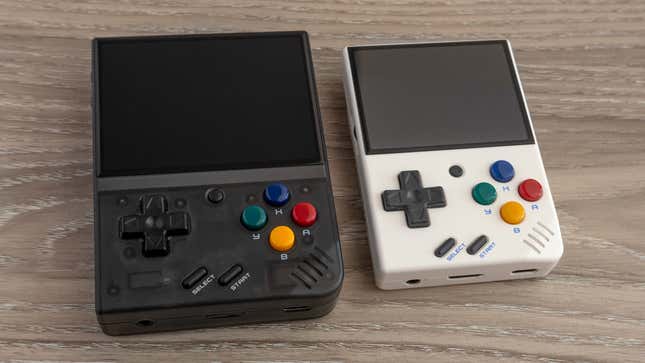
I admittedly have larger hands than most, and while I have spent a lot of time gaming on the original Miyoo Mini over the past year, after about half an hour of playing on the device, my hands still start to feel cramped. The size of the Miyoo Mini Plus’ D-pad and action buttons are no different than the original, but they’re spaced out a little more, which goes a long way toward making the handheld more comfortable to hold for longer gaming sessions.
Advertisement
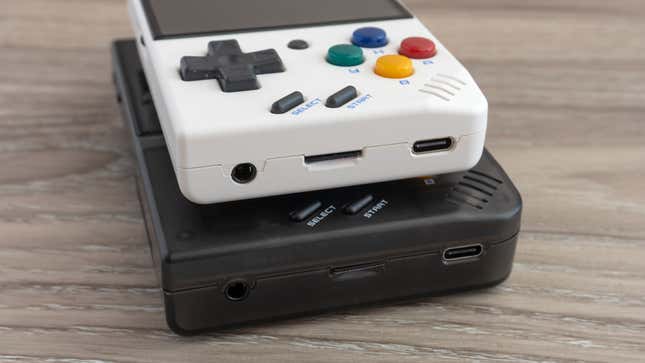
The Miyoo Mini Plus is also a bit thicker than the original, making it slightly less pocketable, but the increased thickness is a welcome tradeoff, as I also found the added bulk made it easier for my hands to grasp. Like last year’s model, on the bottom of the Miyoo Mini Plus you’ll find a headphone jack, a USB-C charging port, and a microSD slot, which holds games and the device’s OS.
Advertisement
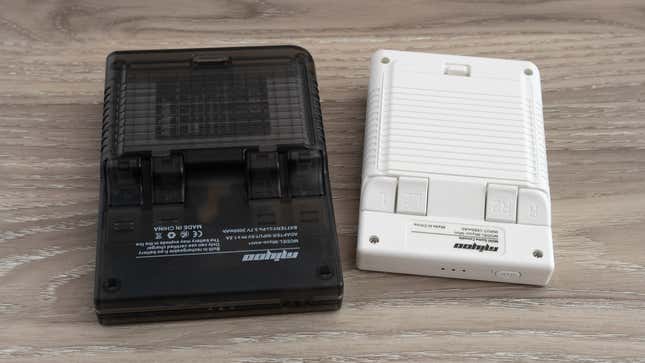
Aside from being slightly larger, the recipe didn’t really change all that much between the original Miyoo Mini and the new Plus version, but there are a couple of other small improvements I’ve come to appreciate. On the back you’ll still find two sets of shoulder buttons, but on the Miyoo Mini Plus they have a more pronounced J-shape design that I find easier to grab with the tips of my fingers.
Advertisement
The Miyoo Mini Plus’ shoulder buttons are much larger, too, with the inner pair sitting noticeably higher than the outer pair, making them easier to distinguish by touch alone. It’s a small design refinement, but it goes a long way toward making games from the 16-bit era—when gamepads and controllers gained shoulder buttons—much easier to play
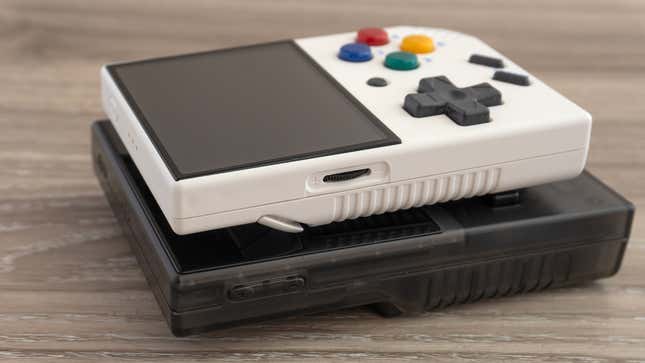
Advertisement
The least significant update, but one that I also welcome, was a switch from an analog wheel for volume control to a rocker button. Although it’s much easier to quickly turn the volume up or down using a thumbwheel, the volume buttons on the side of the Miyoo Mini Plus can be used for other functions, including as a shortcut for adjusting the brightness of the screen.
No Performance Gains, But You’ll Want to Ditch That Stock OS As Fast As You Can
The Miyoo Mini Plus’ slightly larger battery that doesn’t provide any gain for the amount of time you can play as a result of the larger screen. The internals of the handheld are exactly the same as the original, with a 1.2GHz processor and 128MB of RAM. So performance-wise, the Miyoo Mini Plus can handle retro games dating back to the earliest Atari models, and right on up to the original PlayStation. You might have some success with less-demanding games from later consoles, such as the Sega Dreamcast, but given the Miyoo Mini Plus lacks any analog controls, the PS1 is probably a safe cutoff when it comes to what games you choose to emulate.
A Note on Emulation: Unlike the consoles from Nintendo, Sega, Sony, and Microsoft, which run software from cartridges, discs, or by downloading it from official online game stores, many third party retro handhelds like this rely on ROM files played through software emulation. A certain level of technical competency is required to get ROM files onto a retro handheld, and to configure the emulators for optimal gameplay performance. Using ROM files to play games instead of their original distribution media is also a legal gray area. Although emulation software and frontends such as RetroArch have not faced any major legal challenges to their development, companies like Nintendo have used legal means to shut down websites providing ROM files for download.
Advertisement
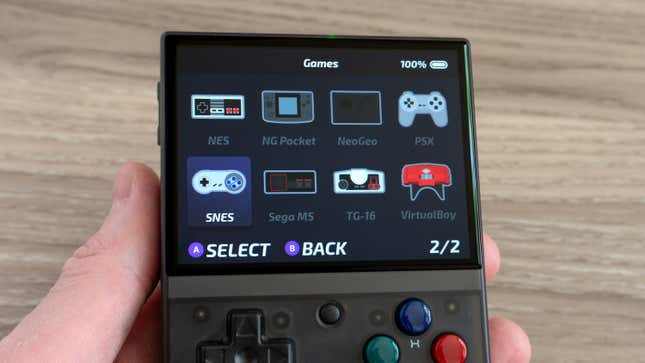
Like the original Miyoo Mini, the Plus ships with a Linux-based operating system that provides a more streamlined frontend for the RetroArch software that handles all of the game emulation. It’s not pretty, and, thankfully, you don’t have to use it. Another thing that made the Miyoo Mini such a popular gaming device was the community behind it who actually created a custom operating system for it called OnionOS.
Advertisement
In addition to being a welcome facelift with swappable themes, OnionOS optimized RetroArch for the Miyoo Mini’s hardware, and made the handheld feel as polished as a device from a big company like Nintendo. It’s also completely free, and while at the time of writing you’ll have to use a Beta release in order to install OnionOS on the Miyoo Mini Plus (the Plus isn’t officially supported by release versions of OnionOS just yet), it’s been rock solid for me so far.
Should You Choose the Original Miyoo Mini or the New Miyoo Mini Plus?
This question is a bit of a moot point, given the original Miyoo Mini is no longer in production. The company simply gave up trying to source the handheld’s 2.8-inch screen and has gone all in on the Miyoo Mini Plus. But since scalpers had a field day with the original, you can still find the smaller Miyoo Mini on sites like eBay, if you’re willing to pay a premium. But should you?
Advertisement
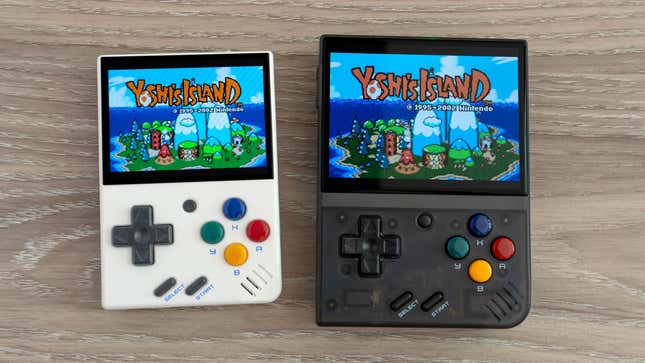
As much as I prefer the larger size of the Miyoo Mini Plus and find it more comfortable to hold and actually play games on, I’m incredibly disappointed with the quality of its 3.5-inch, 640 x 480 LCD screen, and I’m seemingly not alone. Other users have reported issues with the display on various forums, but my biggest complaint is a simple one: it looks awful.
Advertisement
It does have slightly better viewing angles than the screen on the original Miyoo Mini, but I had to make extensive adjustments in the OnionOS’ settings to get the colors to look more accurate, and even then, titles like Yoshi’s Island for the SNES still look muddy, undersaturated, and just plain ugly. Games look much better on the original Miyoo Mini, and while the quality of the Miyoo Mini Plus’ screen doesn’t affect gameplay, it’s hard to ignore. For me, it’s a dealbreaker, but I’m not sure paying $200 for an out-of-production Miyoo Mini is a better alternative.
Should You Choose the Miyoo Mini Plus or the Anbernic RG35XX?
As I mentioned earlier, while the creators of the Miyoo Mini were struggling to make enough Minis to meet demand, companies like Anbernic, who’ve been making very good, sub-$100 handheld emulators for a few years now, took advantage of both the demand and the lack of supply. The result was the oddly named Anbernic RG35XX released earlier this year. When I reviewed it back in March, I was thoroughly impressed with the quality of the hardware and its performance, given its $65 price tag, but was hesitant to recommend it with the Miyoo Mini Plus still en route.
Advertisement
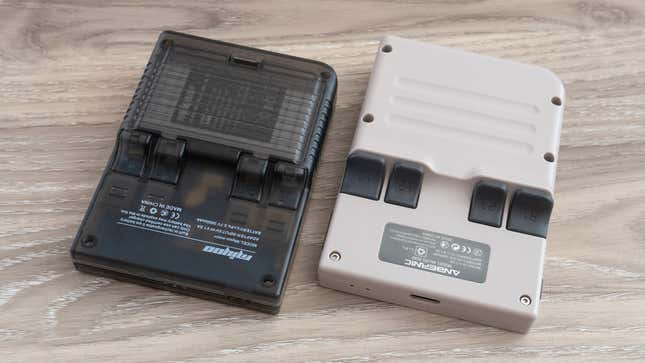
Having tested both systems for a while now, I think the Anbernic RG35XX is definitely the better choice. It offers the same level of performance as the Miyoo Mini Plus, emulating thousands of retro games right on up to the PS1 era, with larger, more comfortable controls—including beefy shoulder buttons on the back—dual microSD card slots for keeping your game files and OS files separate, and even a Mini-HDMI port for playing games on a larger screen.
Advertisement
Unfortunately, the excellent OnionOS isn’t available for the Anbernic RG35XX, but you can upgrade its stock OS and front-end with a much better alternative called GarlicOS, developed by Black-Seraph. It’s not quite as robust as OnionOS, but it still adds a lot of polish to the RG35XX, while also streamlining and optimizing RetroArch.
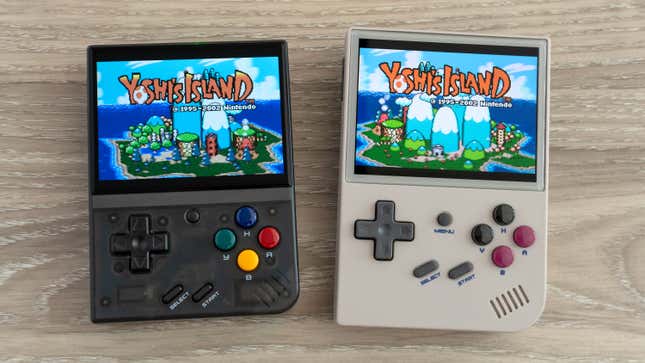
Advertisement
But what makes the Anbernic RG35XX, which is actually a few bucks cheaper than the Miyoo Mini Plus, a better buy, is its vastly superior screen. Side-by-side, the RG35XX’s display makes the Miyoo Mini Plus’ look absolutely terrible, almost like I forgot to remove a tinted screen protector after opening it. (There wasn’t one.) The RG35XX’s screen isn’t the best display Anbernic has ever put on one of its devices, but it far outperforms that of the Miyoo Mini Plus, and for me, makes the decision between the two an easy one: go with the Anbernic RG35XX.
Services Marketplace – Listings, Bookings & Reviews